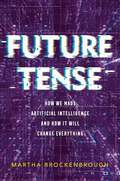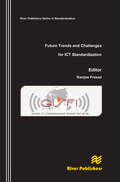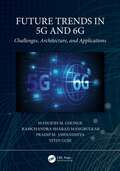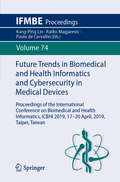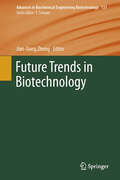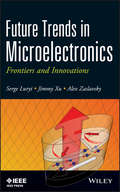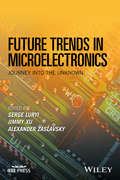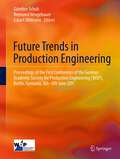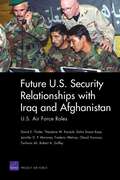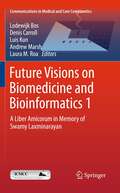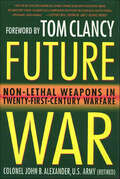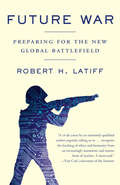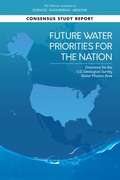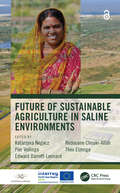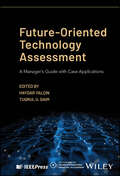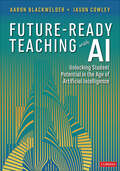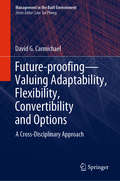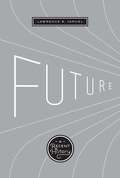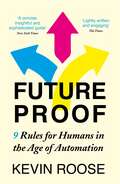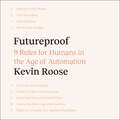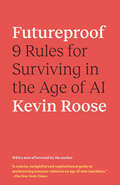- Table View
- List View
Future Tense: How We Made Artificial Intelligence—and How It Will Change Everything
by Martha BrockenbroughHuman history has always been shaped by technology, but AI is like no technology that has come before it. Unlike the wheel, combustion engines, or electricity, AI does the thing that humans do best: think. While AI hasn’t reproduced the marvelously complex human brain, it has been able to accomplish astonishing things. AI has defeated our players at games like chess, Go, and Jeopardy!. It’s learned to recognize objects and speech. It can create art and music. It’s even allowed grieving people to feel as though they were talking with their dead loved ones.On the flip side, it’s put innocent people in jail, manipulated the emotions of social media users, and tricked people into believing untrue things.In this non-fiction book for teens, acclaimed author and teacher Martha Brockenbrough guides readers through the development of this world-changing technology, exploring how AI has touched every corner of our world, including education, healthcare, work, politics, war, international relations, and even romance. This is essential reading for anyone who wants to understand how artificial intelligence got here, how to make the best use of it, and how we can expect it to transform our lives.
Future Trends and Challenges for ICT Standardization
by Ramjee PrasadThis book comes in response to the Future Trends and Challenges for ICT Standardization. The technological areas covered are:• the need, importance and management of radio spectrum,• the development of future radio access technologies,• the convergence of telecommunications and broadcasting,• the possibilities and challenges brought by the Internet of Things (IoT),• the environment sustainability through the use of Green ICT,The book aims at identifying the importance of ICT standardization for strengthening the Indian industrial and business sector through Global ICT Standardization Forum for India (GISFI-www.gisfi.org). Further, it outlines the major challenges and trends in the ICT development worldwide, while mapping the Indian efforts on the background of the overall progress.The motivation behind this book is that a more informed context is made available to ensure sustainable scientific and economic growth.Finally, the book puts forward the best research roadmaps, strategies and challenges contributed by engineers from the industry, academia, and Government. It addresses the benefits to the entire society resulting from standardization.
Future Trends and Challenges of Molecular Imaging and AI Innovation: Proceedings of FASMI 2020 (Springer Proceedings in Physics #272)
by Kang-Ping Lin Ren-Shyan Liu Bang-Hung YangThis volumes presents the proceedings of the FASMI 2020 conference, held at Taipei Veterans General Hospital on November 20-22, 2020. It presents contributions on all aspects of molecular imaging, discovered by leading academic scientists and researchers. It also provides a premier interdisciplinary treatment of recent innovations, trend, and concerns as well as practical challenges and solutions in Molecular Imaging and put an emphasis on Artificial Intelligence applied to Imaging Data. FASMI is the annual meeting of the Federation of Asian Societies for Molecular Imaging
Future Trends in 5G and 6G: Challenges, Architecture, and Applications
by Ramchandra Sharad Mangrulkar Mangesh Ghonge Pradip M Jawandhiya Nitin GojeFuture Trends in 5G and 6G: Challenges, Architecture, and Applications offers a comprehensive overview of basic communication and networking technologies. It focuses on emerging technologies, such as Software-Defined Network (SDN)-based ad hoc networks, 5G, Machine Learning, and Deep Learning solutions for communication and networking, Cloud Computing, etc. It also includes discussions on practical and innovative applications, including Network Security, Smart Cities, e-health, and Intelligent Systems. The book addresses several key issues in SDN energy-efficient systems, the Internet of Things, Big Data, Cloud Computing and Virtualization, Machine Learning, Deep Learning, Cryptography, and 6G wireless technology and its future. It provides students, researchers, and practicing engineers with an expert guide to the fundamental concepts, challenges, architecture, applications, and state-of-the-art developments in communication and networking.
Future Trends in Biomedical and Health Informatics and Cybersecurity in Medical Devices: Proceedings of the International Conference on Biomedical and Health Informatics, ICBHI 2019, 17-20 April 2019, Taipei, Taiwan (IFMBE Proceedings #74)
by Paulo De Carvalho Ratko Magjarevic Kang-Ping LinThis book gathers the proceedings of the IV International Conference on Biomedical and Health Informatics (ICBHI 2019), held on 17-20 April, 2019, in Taipei, Taiwan. Contributions span a range of topics, including medical imaging, biosignal processing, biodata management and analytics, public and personalized health systems, mobile health applications and many more. The IV conference edition gave a special emphasis to cybersecurity issues and cutting-edge medical devices, as it is reflected in this book, which provides academics and professionals with extensive knowledge on and a timely snapshot of cutting-edge research and developments in the field of biomedical and health informatics.
Future Trends in Biotechnology
by Jian-Jiang ZhongSystems Metabolic Engineering: The Creation of Microbial Cell Factories by Rational Metabolic Design and Evolution, by Chikara Furusawa, Takaaki Horinouchi, Takashi Hirasawa, Hiroshi Shimizu Impacts of Quorum Sensing on Microbial Metabolism and Human Health, by Yang-Chun Yong, Jian-Jiang Zhong CHO Glycosylation Mutants as Potential Host Cells to Produce Therapeutic Proteins with Enhanced Efficacy, by Peiqing Zhang, Kah Fai Chan, Ryan Haryadi, Muriel Bardor, Zhiwei Song Cell-Free Biosystems for Biomanufacturing, by Chun You, Y.-H. Percival Zhang Lipid Bilayer Membrane Arrays: Fabrication and Applications, by Xiaojun Han, Guodong Qi, Xingtao Xu, Lei Wang RNA Aptamers: A Review of Recent Trends and Applications, by Kyung-Nam Kang, Yoon-Sik Lee
Future Trends in Microelectronics
by Alexander Zaslavsky Serge Luryi Jimmy XuLeaders in the field predict the future of the microelectronics industryThis seventh volume of Future Trends in Microelectronics summarizes and synthesizes the latest high-level scientific discussions to emerge from the Future Trends in Microelectronics international workshop, which has occurred every three years since 1995. It covers the full scope of cutting-edge topics in microelectronics, from new physical principles (quantum computing, correlated electrons), to new materials (piezoelectric nanostructures, terahertz plasmas), to emerging device technologies (embedded magnetic memories, spin lasers, and biocompatible microelectronics).An ideal book for microelectronics professionals and students alike, this volume of Future Trends in Microelectronics:Identifies the direction in which microelectronics is headed, enabling readers to move forward with research in an informed, efficient, and profitable mannerIncludes twenty-nine contributor chapters by international authorities from leading universities, major semiconductor companies, and government laboratoriesProvides a unified, cohesive exploration of various trends in microelectronics, looking to future opportunities, rather than past successes
Future Trends in Microelectronics: Journey into the Unknown
by Alexander Zaslavsky Serge Luryi Jimmy XuPresents the developments in microelectronic-related fields, with comprehensive insight from a number of leading industry professionals The book presents the future developments and innovations in the developing field of microelectronics. The book's chapters contain contributions from various authors, all of whom are leading industry professionals affiliated either with top universities, major semiconductor companies, or government laboratories, discussing the evolution of their profession. A wide range of microelectronic-related fields are examined, including solid-state electronics, material science, optoelectronics, bioelectronics, and renewable energies. The topics covered range from fundamental physical principles, materials and device technologies, and major new market opportunities. Describes the expansion of the field into hot topics such as energy (photovoltaics) and medicine (bio-nanotechnology) Provides contributions from leading industry professionals in semiconductor micro- and nano-electronics Discusses the importance of micro- and nano-electronics in today's rapidly changing and expanding information society Future Trends in Microelectronics: Journey into the Unknown is written for industry professionals and graduate students in engineering, physics, and nanotechnology. Serge Luryi, PhD, is a Distinguished Professor and Chair of Electrical and Computer Engineering at Stony Brook University, as well as the Director of New York State Center for Advanced Technology in Sensor Systems. He has worked in microelectronics for over 30 years, published over 250 papers and has been awarded 53 US patents. He is a Fellow of the IEEE, of the American Physical Society, and of the Optical Society of America. Jimmy Xu, PhD, is the Charles C. Tillinghast Jr. '32 University Professor of Engineering and Physics at Brown University. Prior to 1999, he was the James Ham Chair of Optoelectronics, as well as the Director of the Nortel Institute for Telecommunications at the University of Toronto. He has worked in microelectronics for over 30 years. He is a Fellow of the AAAS, APS, Guggenheim Foundation, IEEE, and the Institute of Physics. Alex Zaslavsky, PhD, is a Professor of Engineering and Physics at Brown University. During 2009-2012 he was a Visiting Senior Chair of Excellence at the Nanosciences Foundation in Grenoble, France. He has worked in microelectronics for over 25 years and has published over 130 journal papers and book chapters. He has been an editor of the Solid State Electronics international journal since 2003.
Future Trends in Production Engineering
by Günther Schuh Eckart Uhlmann Reimund NeugebauerTo meet and adapt to the current and future trends and issues in technology and society, the science committee of The German Academic Society for Production Engineering (WGP) continues to define future topics for production technology. These themes represent not only the key focus for the scientific work of the WGP, but also the central themes of the first annual conference in June 2011, whose paper is publically available in this volume. Such themes, including electric mobility, medical technology, lightweight construction, and resource efficiency, as well as mass production ability have all been identified as future, large-scale, and long-term drivers of change. Future trends influence changes sustainably and fundamentally; they permeate society, technology, economics, and value systems and have an effect in virtually all areas of life. The WGP has, as part of its research, established for itself the goal of not only observing these emerging changes, but also of supervising and influencing their development in order to ensure steady progress, secure sustainability, and shape the future.
Future U.S. Security Relationships with Iraq and Afghanistan
by Frederic Wehrey David E. Thaler Dalia Dassa Kaye Jennifer D. Moroney Theodore W. KarasikThe authors describe possible regional security structures and bilateral U.S. relationships with Iraq and Afghanistan. They recommend that the United States offer a wide range of security cooperation activities to compatible future governments in Kabul and Baghdad but should also plan to hedge against less-favorable contingencies. They emphasize that the U.S. Air Force should expect to remain heavily tasked for the foreseeable future.
Future Visions on Biomedicine and Bioinformatics 2
by Luis Kun Laura M. Roa Denis Carroll Lodewijk Bos Andrew MarshSwamy Laxminarayan was an outstanding researcher active in many diverse fields of science and technology. He was one of the most prominent biomedical scientists and his ideas influenced the Biomedical Technology substantially. This book tries to provide an overview on the multiple achievements of Swamy Laxminarayan. It presents a collection of his most outstanding publications and an overview on his outstanding life. This Volume is the second part of the liber amicorum in Memory of Swamy Laxminarayan.
Future War: Non-Lethal Weapons in Twenty-First-Century Warfare
by John B. AlexanderThe nature of warfare has changed! Like it or not, terrorism has established a firm foothold worldwide. Economics and environmental issues are inextricably entwined on a global basis and tied directly to national regional security. Although traditional threats remain, new, shadowy, and mercurial adversaries are emerging, and identifying and locating them is difficult. Future War, based on the hard-learned lessons of Bosnia, Haiti, Somalia, Panama, and many other trouble spots, provides part of the solution.Non-lethal weapons are a pragmatic application of force, not a peace movement. Ranging from old rubber bullets and tear gas to exotic advanced systems that can paralyze a country, they are essential for the preservation of peace and stability. Future War explains exactly how non-lethal electromagnetic and pulsed-power weapons, the laser and tazer, chemical systems, computer viruses, ultrasound and infrasound, and even biological entities will be used to stop enemies. These are the weapons of the future.
Future War: Preparing for the New Global Battlefield
by Robert H. LatiffAn urgent, prescient, and expert look at how future technology will change virtually every aspect of war as we know it and how we can respond to the serious national security challenges ahead. Future war is almost here: battles fought in cyberspace; biologically enhanced soldiers; autonomous systems that can process information and strike violently before a human being can blink. A leading expert on the place of technology in war and intelligence, Robert H. Latiff, now teaching at the University of Notre Dame, has spent a career in the military researching and developing new combat technologies, observing the cost of our unquestioning embrace of innovation. At its best, advanced technology acts faster than ever to save the lives of soldiers; at its worst, the deployment of insufficiently considered new technology can have devastating unintended or long-term consequences. The question of whether we can is followed, all too infrequently, by the question of whether we should. In Future War, Latiff maps out the changing ways of war and the weapons technologies we will use to fight them, seeking to describe the ramifications of those changes and what it will mean in the future to be a soldier. He also recognizes that the fortunes of a nation are inextricably linked with its national defense, and how its citizens understand the importance of when, how, and according to what rules we fight. What will war mean to the average American? Are our leaders sufficiently sensitized to the implications of the new ways of fighting? How are the attitudes of individuals and civilian institutions shaped by the wars we fight and the means we use to fight them? And, of key importance: How will soldiers themselves think about war and their roles within it? The evolving, complex world of conflict and technology demands that we pay more attention to the issues that will confront us, before it is too late to control them. Decrying what he describes as a "broken" relationship between the military and the public it serves, Latiff issues a bold wake-up call to military planners and weapons technologists, decision makers, and the nation as a whole as we prepare for a very different future.
Future Water Priorities for the Nation: Directions For The U. S. Geological Survey Water Mission Area
by Engineering Medicine National Academies of SciencesSolving problems related to use of water resources will be of paramount importance in coming decades as increasing pressure from growing populations, climate change, extreme weather, and aging water-related infrastructure threaten water availability and quality. The Water Mission Area (WMA) of the U.S. Geological Survey (USGS) has a long-established reputation for collecting and delivering high-quality, unbiased scientific information related to the nation’s water resources. WMA observations help inform decisions ranging from rapid responses during emergencies such as hurricanes, floods, and forest fires, to the long-term management of water resources. Produced at the request of USGS, this report identifies the nation’s highest-priority water science and resources challenges over the next 25 years. Future Water Priorities for the Nation summarizes WMA’s current water science and research portfolio, and recommends strategic opportunities for WMA to more effectively address the most pressing challenges.
Future of Management: Proceedings of ICMR-2024
by Koustubh Kanti RayIn response to unparalleled challenges and opportunities, the scope of management is undergoing a profound transformation. Organisations must adapt and innovate in order to flourish in an era characterised by rapid technological advancements, climate change, shifting demographics, and evolving social norms. The three pillars of modern management— sustainability, diversity, and inclusivity—reflect a comprehensive approach that prioritises the well-being of people and the planet over short-term profits and reflects a commitment to social responsibility. In the current era of management, sustainability has emerged as a critical issue. Organisations must incorporate ethical considerations into their decision-making processes, reduce their carbon footprints, and implement eco-conscious practices as the effects of climate change become more severe. According to Paul Polman, the former CEO of Unilever, “Sustainability is not a charity; it is a business case.”
Future of Networks: Modern Communication Infrastructure (Synthesis Lectures on Communications)
by Dhiman Deb ChowdhuryThis book provides a comprehensive discussion about the trends in network transformation towards intelligent networks and what the future holds for communication infrastructure. The author unveils the interplay of technologies and technological know-how that are shaping the industry. Delving into the evolution of networking infrastructures from static to dynamic and intelligent, this book explores how these advancements are enhancing user experiences, driving digital transformation in businesses, and revolutionizing the way the world connects. Covering trends in networking technologies, advances in SOCs, cloud networking, automation, network insights (telemetry and observability), container networking, network security, and AI infrastructure, readers will gain valuable insights into the cutting-edge technologies shaping the landscape of communication infrastructure. Whether you're a seasoned industry professional or a newcomer to the field, this book offers an invaluable resource for understanding the latest advancements and future directions in networking technology.
Future of Sustainable Agriculture in Saline Environments
by Katarzyna NegaczFood production on present and future saline soils deserves the world’s attention particularly because food security is a pressing issue, millions of hectares of degraded soils are available worldwide, freshwater is becoming increasingly scarce, and the global sea-level rise threatens food production in fertile coastal lowlands. Future of Sustainable Agriculture in Saline Environments aims to showcase the global potential of saline agriculture. The book covers the essential topics, such as policy and awareness, soil management, future crops, and genetic developments, all supplemented by case studies that show how this knowledge has been applied. It offers an overview of current research themes and practical cases focused on enhancing food production on saline lands. FEATURES Describes the critical role of the revitalization of salt-degraded lands in achieving sustainability in agriculture on a global scale Discusses practical solutions toward using drylands and delta areas threatened by salinity for sustainable food production Presents strategies for adaptation to climate change and sea-level rise through food production under saline conditions Addresses the diverse aspects of crop salt tolerance and microbiological associations Highlights the complex problem of salinity and waterlogging and safer management of poor-quality water, supplemented by case studies A PDF version of this book is available for free in Open Access at www.taylorfrancis.com. It has been made available under a Creative Commons Attribution-Non Commercial-No Derivatives 4.0 license.
Future-Oriented Technology Assessment: A Manager's Guide with Case Applications (IEEE Press Series on Technology Management, Innovation, and Leadership)
by Tugrul U. Daim Haydar YalçınComprehensive resource explaining how to evaluate technologies for different purposes in any industry using four different practical approaches Future-Oriented Technology Assessment offers a comprehensive view of technology assessment structured into three different practical approaches: Technology Evaluation, Technology Roadmapping, and Technology Intelligence. The first four chapters include studies which utilize technology gap analysis, multiple criteria decision analysis, expert assessment quantification or neural networks to evaluate or forecast technology alternatives. The next five chapters apply bibliometric analysis, patent analysis, and network analysis to identify technology trends and the leaders in the field. The final four chapters use technology roadmapping, which charts a comprehensive plan for implementing technology. Additional topics covered in Future-Oriented Technology Assessment include: Smart grid technology as an alternative to fossil fuel consumptionHeat pump water heaters that reduce the cost of energy and improve energy efficiency, with particular focus on research from the US and ChinaNanotechnology in construction in Saudi Arabia to improve heat insulation, energy efficiency, and tensile strength in green building designs With comprehensive, practical insight into evaluating emerging technologies across different industries, Future-Oriented Technology Assessment is an essential read for researchers in technology and professionals in engineering and technology management, along with professionals and graduate students in related disciplines and programs of study.
Future-Ready Teaching With AI: Unlocking Student Potential in the Age of Artificial Intelligence (Corwin Teaching Essentials)
by Aaron Blackwelder Jason CowleyPrepare your students for a future where AI literacy is crucial Artificial intelligence (AI) is here and seems on the brink of transforming education. As teachers, we know that AI will not diminish the need for students to learn essential skills. It will, however, change how we teach and will require us to develop new skill sets for instruction and assessment. Teachers have a new opportunity—to embrace future-ready instruction that prepares students to engage in a world that expects them to be AI literate. In Future-Ready Teaching With AI: Unlocking Student Potential in the Age of Artificial Intelligence, authors Aaron Blackwelder and Jason Cowley explore the integration of AI in the classroom and its potential to revolutionize teaching. Much more than simply a book about using AI tools, this rich resource aims to help teachers raise rigor, increase engagement, and promote more meaningful learning opportunities in their classrooms as they embrace the future of teaching and learning. Offering evergreen principles and strategies to help educators navigate the age of AI, this book Encourages critical thinking about the ethical use of AI to foster conversations with students Highlights various practical tools that can help teachers meet diverse student learning needs as well as create AI-proof assignments Includes chapter vignettes, sample AI prompts, activities, reflective questions, and links to online resources to support teachers′ work in the classroom Examines how to leverage AI to streamline rudimentary tasks such as lesson planning, assessment, and differentiation, allowing teachers to focus on building relationships, providing feedback, and personalizing learning for their students Written by two secondary teachers, this book is an essential resource for K–12 teachers and administrators looking to move beyond the basics of using AI. By equipping educators to become leaders in this transformation, Future-Ready Teaching With AI demonstrates how to harness the power of AI to help every student thrive.
Future-Ready Teaching With AI: Unlocking Student Potential in the Age of Artificial Intelligence (Corwin Teaching Essentials)
by Aaron Blackwelder Jason CowleyPrepare your students for a future where AI literacy is crucial Artificial intelligence (AI) is here and seems on the brink of transforming education. As teachers, we know that AI will not diminish the need for students to learn essential skills. It will, however, change how we teach and will require us to develop new skill sets for instruction and assessment. Teachers have a new opportunity—to embrace future-ready instruction that prepares students to engage in a world that expects them to be AI literate. In Future-Ready Teaching With AI: Unlocking Student Potential in the Age of Artificial Intelligence, authors Aaron Blackwelder and Jason Cowley explore the integration of AI in the classroom and its potential to revolutionize teaching. Much more than simply a book about using AI tools, this rich resource aims to help teachers raise rigor, increase engagement, and promote more meaningful learning opportunities in their classrooms as they embrace the future of teaching and learning. Offering evergreen principles and strategies to help educators navigate the age of AI, this book Encourages critical thinking about the ethical use of AI to foster conversations with students Highlights various practical tools that can help teachers meet diverse student learning needs as well as create AI-proof assignments Includes chapter vignettes, sample AI prompts, activities, reflective questions, and links to online resources to support teachers′ work in the classroom Examines how to leverage AI to streamline rudimentary tasks such as lesson planning, assessment, and differentiation, allowing teachers to focus on building relationships, providing feedback, and personalizing learning for their students Written by two secondary teachers, this book is an essential resource for K–12 teachers and administrators looking to move beyond the basics of using AI. By equipping educators to become leaders in this transformation, Future-Ready Teaching With AI demonstrates how to harness the power of AI to help every student thrive.
Future-proofing—Valuing Adaptability, Flexibility, Convertibility and Options: A Cross-Disciplinary Approach (Management in the Built Environment)
by David G. CarmichaelThis book presents a unifying approach to the valuation of incorporated flexibility. Flexibility, in general terms, recognizes future uncertainty and refers to being proactive now so as to secure the future possibility of being able to adapt, convert, or generally introduce a change, if it is worthwhile to do so at the time. That is, deliberate provision is made now in order to have the ability (but not the obligation) to adapt, convert, or change in the future; this change is discretionary, and depends on future circumstances. The applications demonstrated here cover engineering, building, housing, finance, economics, contracts, general management, and project management. The examples are as follows: designing/building features in infrastructure (including buildings and houses) such that the infrastructure can be adapted in response to future changes in climate, demographics, or usage; incorporating features in contracts such that the terms and conditions can be changed in response to changing situations; purchasing rights now such that options exist to buy or sell an asset in the future; structuring a financial investment agreement so that its terms and conditions can be changed in the future; structuring project payments to provide future guarantees of revenue if needed; and designing an operation such that it can be expanded, contracted, abandoned, switched, changed, delayed, or deferred in the future. The level of required mathematics is kept at a very modest level: an undergraduate knowledge of algebra and probability is all that is required. Numerical examples, accompanied by readily understandable diagrams, illustrate the methods outlined. The formulations are kept straightforward and accessible for practitioners and academics alike.
Future: A Recent History
by Lawrence R. SamuelThe history of our attitudes toward the possibilities of tomorrow:&“A fascinating trek through American future visions from the 1920s to the present.&” —Lori C. Walters, Ph.D., University of Central Florida The future is not a fixed idea but a highly variable one that reflects the values of those who are imagining it. By studying the ways that visionaries imagined the future—particularly that of America—in the past century, much can be learned about the cultural dynamics of the times. In this social history, Lawrence R. Samuel examines the future visions of intellectuals, artists, scientists, businesspeople, and others to tell a chronological story about the history of the future in the past century. He defines six separate eras of future narratives from 1920 to the present day, and argues that the milestones reached during these years—especially related to air and space travel, atomic and nuclear weapons, the women&’s and civil rights movements, and the advent of biological and genetic engineering—sparked the possibilities of tomorrow in the public&’s imagination, and helped make the twentieth century the first century to be significantly more about the future than the past. The idea of the future grew both in volume and importance as it rode the technological wave into the new millennium, and the author tracks the process by which most people, to some degree, have now become futurists as the need to anticipate tomorrow accelerates.
Futureproof: 9 Rules for Humans in the Age of Automation
by Kevin Roose'Kevin Roose provides a clear, compelling strategy for surviving the next wave of technology with our jobs - and souls - intact... Futureproof is the survival guide you need' Charles Duhigg, The Power of HabitIn this timely, counterintuitive, and highly practical guide to the age of A.I. and automation, a New York Times technology columnist argues that the key to success is making yourself more human, not less.The machines are here. After decades of sci-fi doomsaying and marketing hype, advanced A.I. and automation technologies have leapt out of research labs and Silicon Valley engineering departments and into the center of our lives. The world's biggest corporations are racing to automate jobs, and some experts predict that A.I could put millions of people out of work. But all is not lost. With a little effort, we can become futureproof. In Futureproof: 9 Rules for Machine-Age Humans, New York Times technology columnist Kevin Roose lays out an optimistic vision of how people can thrive in the machine age by rethinking their relationship with technology, and making themselves irreplaceably human.
Futureproof: 9 Rules for Humans in the Age of Automation
by Kevin Roose'Kevin Roose provides a clear, compelling strategy for surviving the next wave of technology with our jobs - and souls - intact... Futureproof is the survival guide you need' Charles Duhigg, The Power of HabitIn this timely, counterintuitive, and highly practical guide to the age of A.I. and automation, a New York Times technology columnist argues that the key to success is making yourself more human, not less.The machines are here. After decades of sci-fi doomsaying and marketing hype, advanced A.I. and automation technologies have leapt out of research labs and Silicon Valley engineering departments and into the center of our lives. The world's biggest corporations are racing to automate jobs, and some experts predict that A.I could put millions of people out of work. But all is not lost. With a little effort, we can become futureproof. In Futureproof: 9 Rules for Machine-Age Humans, New York Times technology columnist Kevin Roose lays out an optimistic vision of how people can thrive in the machine age by rethinking their relationship with technology, and making themselves irreplaceably human.(P) 2021 Penguin Random House Audio
Futureproof: 9 Rules for Surviving in the Age of AI
by Kevin RooseA practical, deeply reported survival guide for the age of AI, written by the New York Times tech columnist who has introduced millions to the promise and pitfalls of artificial intelligence. &“Artificial intelligence can be terrifying, but Kevin Roose provides a clear, compelling strategy for surviving the next wave of technology with our jobs—and souls—intact.&”—Charles Duhigg, author of The Power of Habit It&’s time to get real about AI. After decades of hype and sci-fi fantasies, AI—artificial intelligence—is leaping out of research labs and into the center of our lives. Millions of people now use tools like ChatGPT and DALL-E 2 to write essays, create art and finish coding projects. AI programs are already beating humans in fields like law, medicine and entertainment, and they&’re getting better every day. But AI doesn&’t just threaten our jobs. It shapes our entire human experience, steering our behavior and influencing our choices about which TV shows to watch, which clothes to buy, and which politicians to vote for. And while many experts argue about whether a robot apocalypse is near, one critical question has gone unanswered: In a world where AI is ascendant, how can humans survive and thrive? In Futureproof: 9 Rules for Humans in the Age of Automation, New York Times technology columnist Kevin Roose shares the secrets of people and organizations that have successfully navigated waves of technological change, and explains what skills are necessary to stay ahead of the curve today, with lessons like • Be surprising, social, and scarce• Resist machine drift• Leave handprints• Demote your devices• Treat AI like a chimp army Roose rejects the conventional wisdom that in order to compete with AI, we have to become more like robots ourselves—hyper-efficient, data-driven workhorses. Instead, he says, we should focus on being more human, and doing the kinds of creative, inspiring, and meaningful things even the most advanced algorithms can&’t do.
